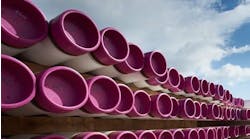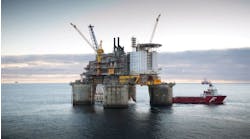Regional analysis could yield global solutions
Judy Maksoud
International Editor
Flow assurance challenges escalate sig-nificantly as tieback distance increases and production moves into deeper water. Maintaining production flow is particularly exigent in harsh envir-onments where colder sea temperatures exacerbate common problems.
The harsh environment offshore Newfoundland and Labrador poses challenges for long distance tiebacks and deepwater risers. Conditions in this region include sub-zero air and water temperatures, seasonal pack ice and icebergs, and severe storm and sea conditions.
These conditions pose cost, schedule, and engineering challenges. The successes of the Hibernia and Terra Nova projects and operations on the Grand Banks have demonstrated the capability to meet these challenges.
null
Looking for solutions
Petro-Canada, which holds interest in major projects on the Grand Banks, has recognized the importance of understanding flow assurance challenges in the region.
Ahmed Ewida, Petro-Canada's engineering and technology manager for the East Coast business unit, heads a team of engineers that are working on offshore engineering, project developments, and technology application in harsh environment. The team has recently completed an analysis of harsh environment flow assurance issues. The primary objective of this work, according to Ewida, was to evaluate flow assurance challenges and to assess potential solutions.
"In order to be pro-active, we want to en-hance our understand- ing of the environment and the effects of the environment on future developments. Our work involved the evaluation of two development applications," Ewida says.
The first was long-distance tiebacks in a moderate water depth of 100 m, where sub-zero water temperatures are encountered, and the second was a deepwater sensitivity analysis at water depths of 500-2,400 m for a fixed tieback distance. Thermal, hydraulic, and hydrate management evaluations were completed for each of the two development applications.
null
null
null
The investigation
Stephen Edison, a process engineer at Petro-Canada East Coast engineering and technology, explains, "For the thermal analyses, our wax management philosophy is to operate such that the temperature in the flowline stays above the wax appearance temperature of the production fluids. We wanted to determine insulation requirements for a given flow rate to meet this wax management strategy."
At greater distances from the FPSO and at increased water depths, more of the flowline/riser system is exposed to cold ocean temperatures, which means the facility arrival temperature is reduced for a given flow rate.
Analyses yielded predicable results, according to Edison. "As tie-back distance or water depth increases, the required flowline/riser insulation value becomes more exacting for a given flow rate."
The team compared local results with the North Sea and Gulf of Mexico. "From an insulation standpoint, offshore Newfoundland has the most onerous requirements for wax management. Interestingly, this effect was more pronounced in shallow/moderate water depths as global water temperatures below ~500 m are generally comparable at about 3° to 4° C," Edison says.
The second component of the analysis scope was hydraulic analysis. "We wanted to determine if we extended outwards from a facility for a moderate water depth, what line size would be required for a given flow rate. We also wanted to evaluate the potential for flow instability in deepwater riser systems," Edison explains.
"What we found for the moderate water depths was that as we increased the distance from a facility for a given flow rate and for given wellhead conditions, we would need a larger line diameter, but nothing that was off the scale, which was a good result for us." With respect to deepwater flow instability, the height of the riser can increase to the point where the static head dominates, creating the potential for hydraulic instability at turndown flow conditions.
Analyses targeted flow rates where riser instability occurred and evaluated the effect of adding riser based gas lift, used to decrease flowing fluid density and riser static head. Results indicated a moderate amount of riser based gas lift (to around 200,000 Sm3/d) can improve flow stability.
According to Edison, "The ability of a moderate amount of riser base gas lift to stabilize flow at turndown conditions allows for a greater range of operating flowrates. Without riser base gas lift, the operability range is significantly reduced compared to a shallow or moderate water depth riser."
The third flow assurance analysis component considered hydrate management and focused on the ability to blow-down flowline contents to pressures below the hydrate formation region during shutdown conditions as water depth is increased.
"Transient simulations at 1,100 and 2,400 m have shown that the hydrate formation pressure of 10 bara (for ambient seawater temperature of 3° C at these water depths) at riser heights greater than 1,100 m could not be reached, rendering a hydrate management philosophy based solely on flowline blow-down ineffective," Edison said. This result implies that for deepwater fields, alternative hydrate mitigation options, such as flowline displacement using stabilized fluids, must be considered.
Looking forward
"The desire of the global oil and gas industry to develop remote and/or deepwater fields has lead to the growth of advanced flow assurance technologies and remedial techniques over the past decade," Ewida says. Some examples of these technologies included subsea multiphase pumping, advanced passive flowline insulation, actively-heated flowlines, deepwater riser base gas lift, and subsea separation.
"Grand Banks add-ons/field extensions and offshore Newfoundland deepwater developments can benefit from the integration of conventional flow assurance mitigation technologies with advanced technology solutions," Ewida says.
Petro-Canada's results are not only applicable to Atlantic Canada, but to other harsh environment areas as well, including the North Sea and offshore Russia, Ewida says. "The fundamentals are the same."








